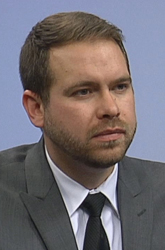Issues & Answers Special Advertising Section
January 2020

Ryan McMahon
Vice President of Insurance and Government Affairs
Cambridge Mobile Telematics

“Just detecting an accident is only part of what is invaluable for an insurance company. CMT has advanced the technology with the help of artificial intelligence to reconstruct the accident.”
What are the friction points when somebody files a claim and the challenges?
The key component in claims is information. Information is required to establish if a loss is covered or not, to establish whether or not you have damages that meet the threshold of the deductible, to determine liability and then ultimately to assess how much is going to be repaired or replaced, and settle that claim. The information is driven from a variety of sources including police reports and unbiased witnesses. But most of the information comes from the policyholder or the claimant themselves and that creates a lot of friction as the process to gather that information is sometimes lengthy.
Are there solutions to address these pain points?
The insurance industry has done a tremendous job of trying to make the claims process as fast as possible over the years by using technology. Now the insurance industry actually has the ability to use telematics to reduce friction. Where telematics has traditionally been used specifically to help identify safe driving behaviors and establish prices from there, now that same information through advanced machine learning and artificial intelligence can reconstruct an accident and get information to the insurance company much faster than was previously able just from a conversation alone.
CMT has added some new components to its product line, Claims Reporter and Crash Detector. What do these technologies do and how do they work?
CMT pioneered the mobile telematics industry out of research that started at the Massachusetts Institute of Technology. Dr. Hari Balakrishnan and Dr. Sam Madden engineered the ability to take data that came from sensors from mobile phones and recreate the same information that was previously only available from a black box or a plug-in device. That has advanced over the years to now, where CMT is able to reconstruct an accident with mobile telematics. CMT has also introduced the ability to detect a crash in real time, and our products have been used in this way over the last five years. The ability to detect a crash in real time and enable the insurance companies to respond is life-saving technology. In fact one of our customers, Discovery Insure in South Africa, notes that their customers have 60% lower road fatality rates than the rest of South African drivers today.
Just detecting an accident is only part of what is invaluable for an insurance company. CMT has advanced the technology with the help of artificial intelligence to reconstruct the accident, specifically with the ability to build a narrative around what happened in the loss, where it happened, what force was behind it, what the damages were, whether it was the front of the vehicle or the rear of the vehicle. That information is now available to our customers and that has come as a result of rigorous testing and advances in technology that again were born out of our initial products started from research at MIT.
View the full spread as it appears in Best's Review print edition.